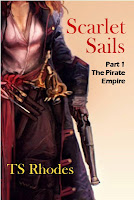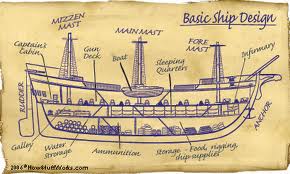Pirates get a lot of attention, but
most of us are more familiar with fictional pirates than real ones. And why not?
Fictional pirates enjoy great lines, wonderful wardrobes, and ships with catchy
names, and never have to deal with bilgewater, scurvy or rats in the hold. Let’s
look at some of the most famous.
5. One-Eyed Willy
Ship: The Inferno, venue: 1985 movie The
Goonies. Willie was a generation’s earliest introduction to pirates, and what
an introduction it was: secret treasure, a mysterious map, and traps only the
kids can solve, all in the name of saving the family home and sticking it to
the rich guys.
One-eyed Willie didn’t bury his
treasure, he walled himself up with it.
Willie’s the story of how pirates
become part of local legend. Both coasts of America and the whole of the
Caribbean are filled with stories of local pirates, their adventures and hints
of their buried treasure. Captain Kidd’s fortune has yet to be found along the
Carolina coast, but a real map led to the 26 million dollars that went down
with Sam Bellamy’s ship. And as long as there are legends of ill-gotten gains,
kids (and adults) will go out in hope finding a little for themselves.
4. The Dread Pirate Roberts
Ship:
The Revenge, venue: The Princess
Bride movie (and the book).
The Princess Bride is one of the
best movies ever made (not like I have an opinion or anything) and part of its
appeal is the mysterious Dread Pirate Roberts. Roberts dresses all in black, wears
a mask to conceal his identity, and is legendary for allowing no survivors on
the ships he captures. As the movie progresses, we learn that the name “Dread
Pirate Roberts” is a franchise, with one man after the other taking the title
as the previous holder retires with his plunder.
TDPR is one of the most famous
pirates ever, but we don’t get to see him doing much pirating. His appeal lies in
his fearsome reputation, his fantastic sword fighting skills, and his classic
costume. And true love. Never forget that.
There is no record of an actual
pirate handing down his name to a successor, but there are plenty of real
pirates who tried to assume an alias, with the plan to go back to using their
own names upon retirement. There are also pirates who flirted with the idea of
leaving no survivors, but none ever committed to such a plan. Ultimately being
a pirate is about having a good time, and killing unarmed captives just didn’t
appeal to that many people.
3. Captain James Hook
Ship: The Jolly Roger, venue: Peter Pan, the play,
several other movies, and a ton of Disney merchandise.
Captain Hook is one of the most
famous pirates ever, and the very model of a pirate captain in action. Hook
lives elegantly on his magnificent ship, dining in his well-appointed cabin, enjoying
the services of a personal servant (Smee), smoking two cigars at a time and playing
the harpsichord. Despite his sometimes effeminate manners, Hook is a tough guy,
bellowing orders in a frightening voice and shooting any member of his crew who
shows signs of rebelling against his iron will.
In fact, Hook is probably the
origin of the myth of the pirate captain as an all-powerful dictator. In fact,
pirate captains were elected by their crews, and could be deposed just as
easily. It would be hard to find a crew loyal to a man who shot subordinates
with so little reason.
Hook’s greatest resemblance to real
pirates lies in his costume (yes, a lot of pirates dressed like that, with the
huge wig, lace shirt and fancy coat) and his desire to be considered a
gentleman. Retiring to a life of wealth and respect was the goal of many a
pirate, and pirate crews from the captain to the lowest powder-monkey plundered
ships of fine clothing, gold watches, wigs, silk stockings and gold shoe buckles
in an effort to appear to be members of
the aristocracy.
2. Long John Silver
Ship: Flint’s
ship the Walrus and later the Hispaniola, venue: Robert Lewis
Stevenson’s novel Treasure Island, and the approximately eighty movies made
from it. Also a string of seafood restaurants.
Long John Silver is the most historically
accurate pirate ever to walk out of the pages of fiction. In the novel, we
first see Silver as the one-legged owner of a seaside eating house, the
Spyglass. Pirates, unlike the Royal Navy, paid a disability benefit to
crewmembers who lost limbs in battle, so the vision of Silver as a business
owner is in keeping with actual pirate practices.
His longing to return to a life of
crime is also typical of real pirates. Several prominent pirates accepted a “King’s
Pardon” or established themselves as rich men under onshore aliases, but almost
all of these returned to piracy when they became bored.
Silver operates under pirate law,
holding his position as leader of the mutineers by popular vote, supplemented by
guile, cunning and manipulation. He does
not have strict control of the crew, who see themselves as free agents, and frequently
lose focus when distracted by rum. Silver needs to keep up appearances to
remain leader, and must hide his growing, fatherly affection for Jim Hawkins in
order to keep his position.
I’ve always believed that the secret
to Treasure Island’s popularity has a lot to do with the fact that Silver gets
away at the end. We still dream that he might show up on OUR doorsteps one day,
with another treasure map and a mouthful of promises he’s probably not going to
keep.
1. Captain Jack Sparrow
Ship: The Black
Pearl, venue: Four Pirates of the Caribbean movies, a string of kid’s
novels, a load of Disney merchandise, and approximately 20,000 posts on Fanfiction.net.
Captain Jack Sparrow, and the big
budget movies he stars in, were the point of entry for millions of pirate fans.
Jack’s got a certain feel of authenticity, even when we know he’s not real. He’s
dishonest and proud of it, clever rather than violent, often in desperate straits,
and deliciously dirty. It was the
worn clothes and the dirt that drew me in first. Jack looked like he lived 300
years ago and worked for a living.
The extras of the first DVD disc
describe the first moment when Johnny Depp went off-script to reveal Jack’s
character. In the original fight with Will Turner, Jack was supposed to draw
his pistol, tell Will, “This shot is not for you,” cock the pistol and point
it. Depp chose to draw, cock the gun, point it at Will, pause for a moment and then deliver the line. It gave Jack a level
of menace that made him believable. Jack Sparrow will kill you, even if you’re
a good guy, because saving his own hide comes first.
Obviously the Aztec curses, zombie
pirates, mermaids, enchanted sea goddesses and trips off the edge of the map
are in no way realistic. But they reflect the way sailors of 300 years ago
viewed their world. No one knew what caused weather, sickness, or a run of bad
luck. Old time sailors were no fools, but they followed superstitions and gave
credit to wild stories because they had no better way to control events around
them.
Jack Sparrow’s life looks a lot
like a real pirate’s in a lot of ways. Real pirates drank heavily, and
sometimes made poor decisions because of it. They wore the same clothes every day,
and rarely bathed. They lived by luck
and reputation as much as by violence.
Johnny Depp famously said that
pirates were the rock stars of their day, and he got it right. Even as pirates
were derided as minions of the devil, breaking the laws of God and Man, their
stories were devoured by contemporaries eager to learn about the cutthorats’
latest exploits. From The General History of the Pyrates (1724), to Treasure
Island (1883), to Pirates of the
Caribbean (2003), we have been fascinated by their adventures, their
deeds of daring, and their lives of freedom.
And now about my own pirate
adventures.
This blog was inspired by research
for my serialized novels, The Pirate Empire by TS Rhodes. The first two
volumes, Scarlet Sails and Gentlemen and Fortune, are now available
on Kindle, with the next volume, Bloody
Sea, due on June 1st of 2013. If you enjoy this blog, I hope you
will choose to purchase the books, and perhaps even to review them on Amazon.
Scarlet Sails

The year is 1717, and pirate Captain Scarlet MacGrath wants nothing more than a
decent meal, a glass of rum and a good
man waiting for her in the next port, but life rarely works out that neatly.
When the rum runs out,
Scarlet sets sail for the mainland to look up an old friend. But friends turn
into enemies pretty quick in this part of the world, and before long Scarlet,
her crew, and the good ship Donnybrook are caught between the lawless Donnelly boys
and the bloody-handed Red Ned Doyle himself. Can Scarlet use her Irish charms
to free herself and her crew, or will it be cutlass and cannon?
Gentlemen and Fortune
The
stormy seas of the Caribbean are home to rogues and gentlemen, Navy captains
and pirate ships like Scarlet's own Donnybrook. Join Scarlet and her crew of outlaws,
misfits, and runaway slaves as they carry out missions of diplomacy, mercy and
aggression.
The pirates are
gathering strength, but they're still hunted by Navy frigates, and soon it's Scarlet's turn to
dance with death in the form of Navy Captain Robert Davenport. Scarlet's used
to sailing close to the wind, but can she sail away from the HMS Nightingale
and the long arm of English law?
Bloody Sea
First it’s an uneasy alliance with the
Donnelly brothers in a clash against bloodthirsty natives, then a seaborne attack
goes awry, leaving the Donnybrook and
her captain crippled. With their very survival on the line, Scarlet and her
crew must find greater courage than ever before. Join Scarlet MacGrath in her most desperate
moments, marshalling muskets, cannon and magic against forces bent on her destruction
as she and her crew sail The Bloody Sea. Available on Kindle June 1.















